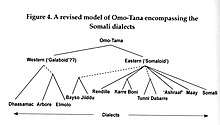Ashraf dialect
Ashraf (Somali: Af-Ashraaf) is a speech variety of uncertain classification within the East Omo-Tana sub-branch found in the Marka district of the Lower Shebelle region and Banaadir region of Southern Somalia.
| Ashraaf | |
|---|---|
| Af-Ashraaf | |
| Native to | Somalia |
| Region |
|
Afro-Asiatic
| |
| Language codes | |
| ISO 639-3 | (included in som) |
| Glottolog | afas1238[1] |
Classification
According to Blench (2006) there are two sub-dialects: Shingani and Lower Shebelle.[2] As noted in recent work on the speech variety, Green & Jones (2016)[3]:
"What we hope to have illustrated in this talk is that while Marka (Af Ashraaf) may be similar in certain ways to both Northern Somali and Maay, it nonetheless boasts a number of unique properties, particularly in its morphology, that we believe merit its treatment not as a Somali or Maay dialect, but as a language variety of its own"
A similar level of skepticism towards the labelling of other Omo-Tana languages in Somalia (such as Maay, Dabarre, Jiddu, so forth) is expressed in Tosco (2012)[4]:
Tosco's revised model for classifying Omo-Tana, acknowledging both the sociolinguistic situation of Cushitic languages in Somalia labeled as "dialects" of Somali and their actual classification as languages apart from Somali"It is well-known that the term 'dialects' may refer to different 'things'. Within Somalia, it is safe to say that all the Somali dialects are 'dialects' from a sociolinguistic point of view, that is, in terms of their social role, their general absence in written media, and the speakers' acceptance of Northern-Central Somali as a common medium. From a strictly linguistic point of view, however, mutual comprehension should be assessed and dialects labelled accordingly (as mutually understandable varieties of a language). No classification so far does that."
Phonology
The phonological inventory of Ashraaf is as follows:
| Bilabial | Labio- dental |
Dental | Alveolar | Post- alveolar (Palato- alveolar) |
Retroflex | Palatal | Velar | Uvular | Pharyngeal | Glottal | ||||||||
|---|---|---|---|---|---|---|---|---|---|---|---|---|---|---|---|---|---|---|
| Plosive | b | t | d | ɖ | k | ɡ | ʔ | |||||||||||
| Fricative | (ɸ) | (β) | f | (ð) | s | ʃ | ɣ | χ | ħ ʕ | h | ||||||||
| Nasal | m | n | ||||||||||||||||
| Trill | r | |||||||||||||||||
| Approximant | j | |||||||||||||||||
| Lateral approximant | l | |||||||||||||||||
| Front | Central | Back | |
|---|---|---|---|
| Close | /i/, /iː/ | /u/, /uː/ | |
| Mid | /e/, /eː/ | /o/, /oː/ | |
| Open | /a/, /aː/ |
References
- Hammarström, Harald; Forkel, Robert; Haspelmath, Martin, eds. (2017). "Af-Ashraaf". Glottolog 3.0. Jena, Germany: Max Planck Institute for the Science of Human History.
- Blench, 2006. The Afro-Asiatic Languages: Classification and Reference List (ms)
- Green, Christopher & Jones, Evan. (2016). A first look at the morphophonology of Marka (Af-Ashraaf) and a comparison to its neighbors.
- The Unity and Diversity of Somali Dialectal Variants. In: Nathan Oyori Ogechi, Jane A. Ngala Oduor and Peter Iribemwangi (eds.), The Harmonization and Standardization of Kenyan Languages. Orthography and other aspects. Cape Town: The Centre for Advanced Studies of African Society (CASAS): 2012: 263-280
Further reading
- Christopher R. Green & Evan Jones. 2019. Notes on the morphology of Marka (AfAshraaf). In Emily Clem, Peter Jenks & Hannah Sande (eds.), Theory and description in African Linguistics: Selected papers from the 47th Annual Conference on African Linguistics, 119–133. Berlin: Language Science Press. DOI:10.5281/zenodo.3367132
- Ajello, Roberto. 1984. Il focus nell'idioma degli Ashraaf di Shingaani. In Puglielli, Annarita (ed.), Aspetti morfologici, lessicali e della focalizzazione, 133-146. Roma: Dipartimento per la Cooperazione allo Sviluppo, Ministero degli Affari Esteri (Italia).
